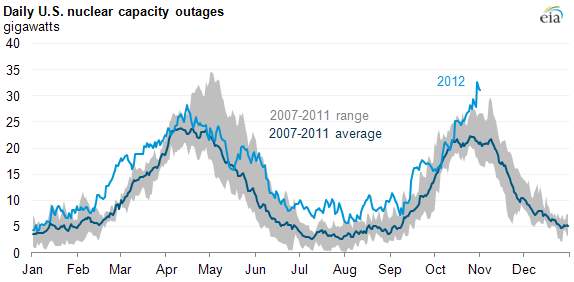The reaction of the futures was a bit of a costly surprise, the draw at 82Bcf was above analysts guesses but considerably below last years withdrawl and the 5-year average pull.
Nuclear outages have declined dramatically from over 30,000 MW at the end of October to 11,900 currently, still above the 5-year but if you remember the Platts story of three weeks ago quite a few operators were/are doing their refueling over the Dec-Jan period rather than the spring shoulder which means the nukes will be cooking during the Feb-Apr time-frame.
The futures are coming back down after their rather exuberant pop, $3.43 up 11 cents and down 3.5 cents from their morning spike.
From Reuters:
* Cool extended weather forecasts help lift prices
* Prices extend gains after weekly EIA storage report
* Near record-high storage, production limit price gains
* Coming Up: Baker Hughes rig data, CFTC trade data Friday
...MORE
Front-month U.S. natural gas futures held gains on Thursday, backed bycolder extended weather forecasts for the Northeast and Midwest and agovernment report showing a larger-than-expected weekly inventory withdrawal.The U.S. Energy Information Administration report showed total domestic gas inventories fell last week by 82 billion cubic feet to 3.724 trillion cubic feet. Traders and analysts polled by Reuters had expected a 72 bcf draw.While traders viewed the withdrawal as supportive relative to expectations - the Reuters poll was looking for a 72 bcf drop - they noted it was still well below last year's 100 bcf pull and the five-year average draw for that week of 144 bcf. Inventories started the heating season in November at an all-time high of 3.929 tcf and are still at record highs for this time of year."The net withdrawal was above the consensus ... (but) still bearish compared with the five-year average draw. We continue to see one more bearish report before colder temperatures translate into above average net withdrawals," Citi Futures energy analyst Tim Evans said in a report.At 11:50 a.m. EST (1650 GMT), front-month gas futures on the New York Mercantile Exchange were up 13.3 cents, or 4 percent, at $3.453 per million British thermal units after climbing to an intraday high of $3.465 after the EIA report.
From the EIA:

Source: U.S. Energy Information Administration, based on data from the Form EIA-923, Power Plant Operations Report, and the U.S. Nuclear Regulatory Commission, Power Reactor Status Reports.
Note: Nuclear capacity in outage is estimated based on monthly generation data collected by EIA and daily availability data from the Nuclear Regulatory Commission.
From Platts Nov. 21:Note: Nuclear capacity in outage is estimated based on monthly generation data collected by EIA and daily availability data from the Nuclear Regulatory Commission.
Nuclear outages to boost US gas demand in December, January: Barclays
Nuclear plant outages will boost US natural gas demand from power generators through January, but a light spring maintenance season will translate into lower gas burn in the first few months of 2013, according to a Barclays Capital report released late Tuesday.From Finviz:
A "drastic drop" in US nuclear plants' output has boosted gas demand from generators so far in November, the analysts said. November's nuclear generation low is possibly record-setting, surpassed only by the heavy turnaround season in spring 2011, they added.
US Nuclear Regulatory Commission data shows nuclear plants are running at an average of 74,769 MW so far this month, about 12,500 MW or 14% lower, than the same time a year ago.
Barclays analysts estimated that if this was replaced entirely by gas-fired generation, it would mean a 2.2 Bcf/d increase in gas demand compared with the same time a year ago.
Announced restart dates and maintenance schedules suggest nuclear plant utilization will be 3,750 MW and 1,900 MW lower in December and January 2013, respectively, than the year-ago levels. If fully replaced by gas, that would translate into an incremental 675,000 Mcf/d and 340,000 Mcf/d, respectively, for those months....MORE